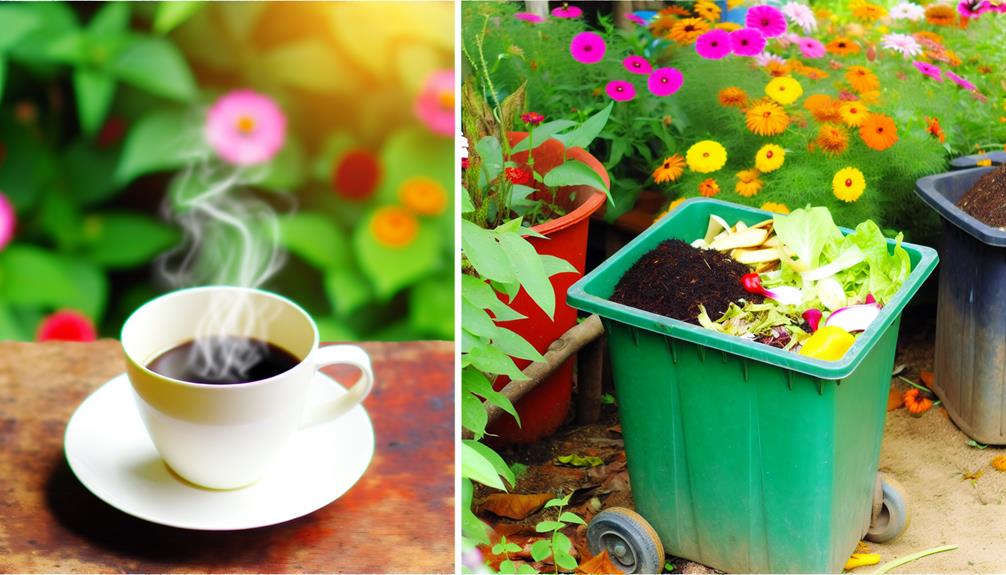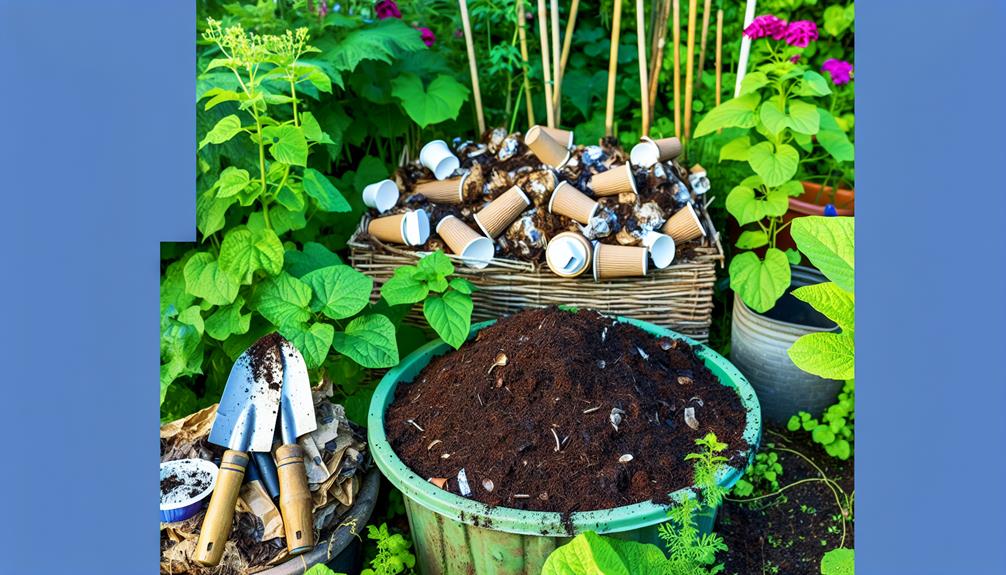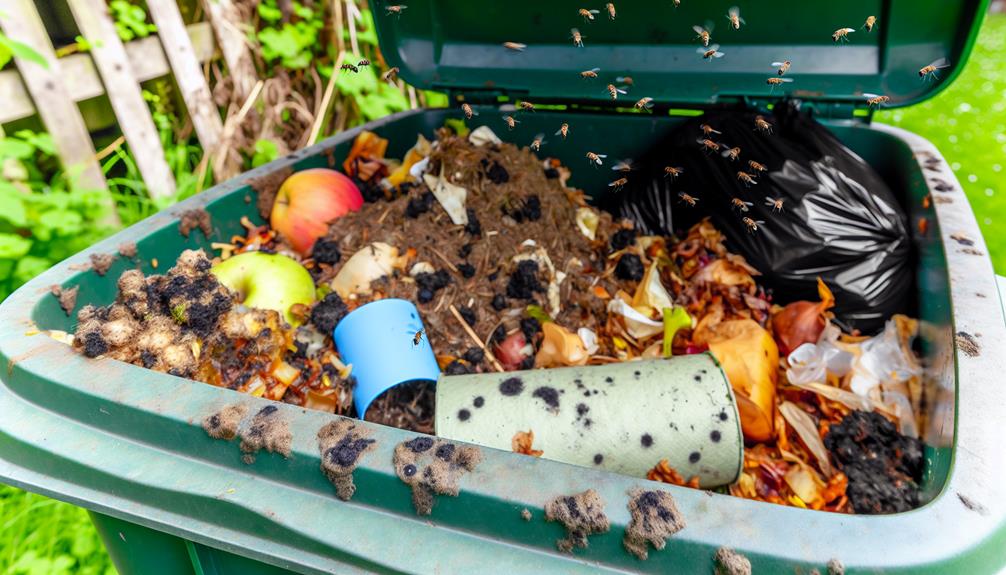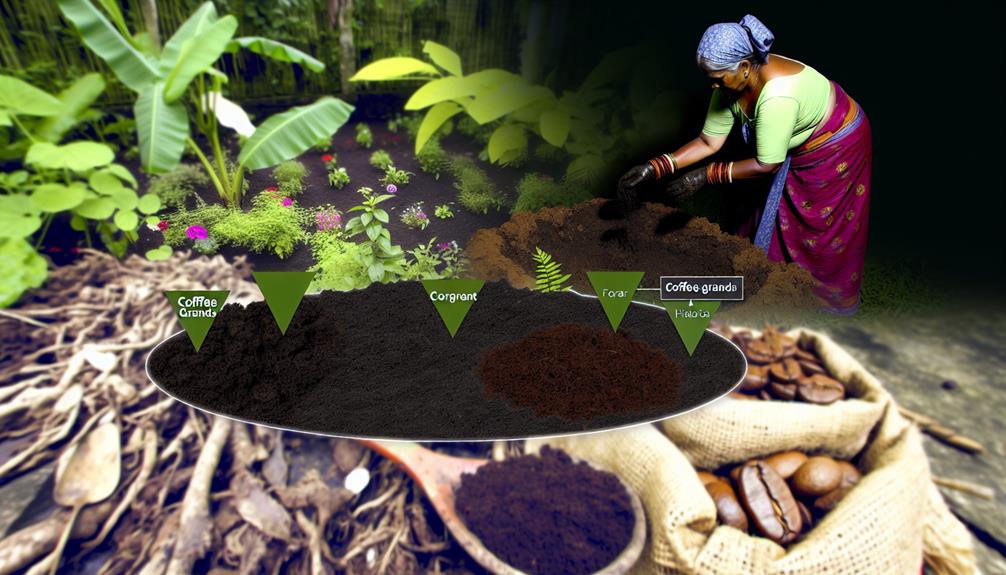

Yes, you can compost coffee grounds and filters. Coffee grounds are rich in nitrogen, which enhances soil fertility and supports beneficial microbes. Simply mix them into your compost pile to balance green and brown materials, speeding up decomposition. Confirm the filters are compostable; tear them into small pieces to accelerate breakdown.
Regularly turn your compost to maintain aeration and proper moisture levels. Using coffee compost in your garden can improve soil structure, provide essential nutrients, and act as a natural pest deterrent. Incorporate these steps, and you’ll see significant benefits for your garden’s health and productivity. Learn more efficient composting practices.
Composting coffee is an excellent way to reduce waste and enrich your garden soil. When you compost coffee grounds, you’re making a positive environmental impact by diverting waste from landfills. Coffee grounds are rich in nitrogen, an essential nutrient for soil health. Instead of tossing your used grounds in the trash, you can turn them into a valuable resource for your garden.
To start, simply collect your coffee grounds in a container. You can mix them directly into your compost pile or compost bin. Coffee grounds break down quickly, so they’re perfect for speeding up the composting process. If you’re already composting kitchen scraps, adding coffee grounds will create a balanced mix of green and brown materials, enhancing the overall efficiency of your compost system.
Additionally, composting coffee contributes to waste reduction. By reusing coffee grounds, you’re reducing your household waste and decreasing your carbon footprint. Every small action, like composting coffee, adds up and makes a difference.
Also Read: Can You Compost Wood Scraps?
Using coffee grounds in your compost can greatly enhance soil fertility by adding essential nutrients.
They also act as a natural pest repellent, helping to keep unwanted insects away from your plants.
Incorporating coffee grounds into your compost can greatly enhance the nutrient content of your soil. When you add coffee grounds, you’re introducing a rich source of nitrogen that soil microorganisms thrive on. These microorganisms play a vital role in nutrient cycling, breaking down organic material and releasing essential nutrients back into the soil. This process guarantees that your plants have access to the nutrients they need for healthy growth.
To maximize the benefits, sprinkle coffee grounds evenly throughout your compost pile. Make sure to balance them with carbon-rich materials like leaves or straw to maintain an ideal compost ratio. Coffee grounds also help improve the soil structure, making it more porous and better at retaining moisture. This improved texture allows plant roots to access water and nutrients more efficiently.
For best results, regularly turn your compost to ensure even decomposition and aeration. This will help the coffee grounds and other materials break down more quickly and integrate fully into the compost. By doing this, you’ll create a nutrient-dense compost that boosts soil fertility, encouraging robust plant growth and a thriving garden ecosystem.
Incorporating coffee grounds is a simple yet effective way to enhance your composting efforts.
Often overlooked, coffee grounds can serve as an effective natural pest repellent in your garden. By integrating them into your compost, you’re not just enhancing soil fertility but also boosting your garden protection. Coffee grounds act as an insect deterrent, keeping pests like ants, slugs, and snails at bay.
When you sprinkle used coffee grounds around plants, the grounds form a barrier that many pests find unpleasant. This natural method of garden protection means you won’t need harmful chemicals. Plus, it’s a great way to recycle coffee waste. Here’s a quick guide on how coffee grounds can help:
| Pest | Effect |
|---|---|
| Ants | Disrupts their scent trails |
| Slugs | Abrasive texture deters movement |
| Snails | Unpleasant to crawl on |
| Cats | Deters from garden areas |
| Mosquitoes | Masks scents they’re attracted to |
To use coffee grounds effectively, simply dry them out and lightly spread them around the base of your plants. You can also mix them with other organic materials in your compost pile. It’s a simple, natural way to keep your garden thriving and pest-free. Embrace this eco-friendly solution and watch your garden flourish!
Also Read: Can You Compost Cauliflower Scraps?
When composting coffee, you’ll encounter different types of waste like coffee grounds, filters, and pods. Each type requires specific handling to guarantee effective composting.

Let’s explore how to use coffee grounds, tips for composting filters, and solutions for pod waste.
You can use various types of coffee waste, like spent coffee grounds and coffee filters, to enrich your compost. Coffee grounds are an excellent source of nitrogen, which is essential for compost. When you add them to your compost bin, they help speed up the decomposition process, making your compost richer and more beneficial for plants. This is one of the many recycling methods that make coffee waste an eco-friendly use in your daily routine.
Start by collecting the coffee grounds from your morning brew. If you use a French press or drip coffee maker, simply gather the spent grounds and add them to your compost pile. You can also use coffee grounds from espresso machines. Just make sure they’re completely cool before adding them.
For those who use paper coffee filters, these can also be added to your compost. They break down easily and contribute to the carbon content, balancing the nitrogen from the coffee grounds. Avoid using filters that are bleached or have synthetic elements.
Besides coffee grounds, coffee filters are another valuable addition to your compost, offering both nitrogen and carbon. Different filter types affect your composting process, so it’s crucial to know what you’re working with. Unbleached paper filters are the most compost-friendly, breaking down quickly. Bleached filters take a bit longer but are still compostable. Some filters are made from synthetic fibers and should be avoided as they won’t decompose.
To help you compost coffee filters effectively, follow these tips:
The composting duration for coffee filters varies, but typically, unbleached filters break down within a few months. Bleached filters might need a bit longer, up to six months. By understanding the filter types and managing your compost pile correctly, you’re contributing to a more sustainable environment.
Many coffee enthusiasts are turning to pod-based systems, but the waste generated from these pods poses a significant environmental challenge. To address this, you can switch to reusable pods. They’re designed to be refilled with your favorite coffee grounds, cutting down on single-use plastic and aluminum waste. By using reusable pods, you not only reduce the volume of waste but also gain more control over the strength and flavor of your coffee.
Another option is to look for pods made with biodegradable packaging. These pods are crafted from materials that break down more easily in composting environments, unlike traditional plastic or aluminum pods. When choosing biodegradable pods, be sure to check if they meet industrial composting standards or if they can be composted at home. This helps guarantee that they decompose properly and don’t contribute to landfill waste.
You can also advocate for more sustainable practices by supporting brands that prioritize eco-friendly packaging and manufacturing. By making these small changes, you become part of a community committed to reducing coffee-related waste and promoting a more sustainable lifestyle. Taking these steps helps secure that your love for coffee doesn’t harm the planet.
Also Read: Can You Compost Cedar Chips?
Incorporating coffee grounds into your compost can greatly boost its nutrient content. Whether you’re using a traditional compost pile, a bin, or a tumbler, coffee grounds are a versatile addition. They’re rich in nitrogen, which is essential for plant growth. While some worry about coffee acidity, the pH level of coffee grounds is closer to neutral, making them safe for most compost types.
Here are four key benefits of adding coffee grounds to your compost:
To get started, simply sprinkle the used grounds over your compost pile and mix them in. Remember, balance is essential. Aim for a mix of green materials (like coffee grounds) and brown materials (like leaves) to maintain an efficient composting process. By integrating coffee grounds, you’re not only reducing waste but also enhancing your gardening efforts, creating a thriving and sustainable ecosystem in your backyard.
When composting coffee, make sure that coffee filters are also compostable and can enhance your compost pile. Coffee filters, typically made from paper, break down easily and contribute valuable carbon to the mix. Start by verifying your filter materials are free from synthetic substances, such as chemicals or plastic linings, which can hinder filter decomposition.

To incorporate used coffee filters into your compost, simply tear them into smaller pieces. This accelerates the decomposition process and helps them blend seamlessly with other compost materials. Remember, the smaller the pieces, the faster they break down.
If you use bleached coffee filters, don’t worry. Most modern bleached filters are processed using oxygen, making them safe for composting. However, unbleached filters are always a safer bet if you want to avoid any potential contaminants.
You can also add the coffee grounds still in the filter directly to your compost pile. This minimizes waste and saves you time. Just mix them well with your existing compost materials to ensure even decomposition.
Achieving the right balance in your compost guarantees that organic matter decomposes efficiently and produces rich, fertile soil. This balance hinges on maintaining the correct carbon ratio and having a proper nitrogen source. To get it right, you’ll need a mix of ‘greens’ (nitrogen-rich materials) and ‘browns’ (carbon-rich materials).
Here are a few steps to help you maintain this balance:
Even with a good understanding of balancing greens and browns, it’s easy to make some common mistakes that can hinder your composting efforts. One frequent error is dealing with overwatering issues. While moisture is necessary for compost to break down, too much water can create a soggy environment. This leads to anaerobic conditions, causing unpleasant odors and slowing decomposition. To guarantee your compost has adequate drainage and turn it regularly to aerate.

Another common mistake is incorrect layering. When you add coffee grounds to your compost, mix them thoroughly with other materials. Simply dumping large quantities of grounds in one spot can result in compacted layers, which hinder airflow and slow down the composting process. Layering finely shredded browns like leaves or straw between your coffee grounds helps maintain balance and promotes efficient breakdown.
Also, avoid adding too many coffee grounds at once. Although they’re a good nitrogen source, overloading your compost can upset the balance and lead to similar problems as overwatering. Aim for a diverse mix of materials to keep your compost healthy. By being mindful of these common mistakes, you’ll create a thriving compost pile that enriches your garden.
To guarantee your composting efforts are successful, focus on maintaining the right balance of materials and consistent aeration. Coffee grounds are rich in nitrogen, but you’ll need to balance them with carbon-rich materials like dried leaves or paper.
Here are some essential tips for success:
Also Read: Can You Compost Broad Beans?
Once your coffee compost is ready, you can use it to enrich garden soil and boost plant growth. Start by incorporating the coffee compost into your garden bed or potting mix. Aim for a ratio of one part compost to three parts soil. This balance guarantees your plants get the nutrients they need without overwhelming them.

Coffee recycling is a sustainable practice that reduces waste and supports healthy soil. The nutrients in the coffee grounds, such as nitrogen, potassium, and phosphorus, are essential for plant growth. When you add coffee compost to your garden, you’re not only feeding your plants but also improving soil structure and drainage.
Be mindful of the caffeine impact, though. While most of the caffeine breaks down during the composting process, small amounts may remain. This isn’t usually a problem for mature plants but could affect seedlings and sensitive species. To be safe, use coffee compost sparingly around young plants.
You can also use coffee compost as mulch. Spread a thin layer around the base of your plants to help retain moisture and suppress weeds.
Your composting practices play a big role in pest prevention. If you mix coffee grounds properly and maintain your compost, you’ll minimize the risk of attracting pests or rodents. Join others in eco-friendly composting and succeed together!
When you’re composting, the decomposition time for coffee grounds is usually around 3-6 months. Coffee breakdown is fairly quick, making it a great addition to your compost pile and helping you feel part of an eco-friendly community.
You might wonder if it’s safe to compost flavored coffee grounds. Generally, flavor additives and chemical residues in flavored coffee can be concerning. Stick to organic, unflavored grounds to keep your compost chemical-free and eco-friendly.
Yes, you can compost moldy coffee grounds. Different mold types contribute to the decomposition rate, helping break down organic matter faster. Including them in your compost fosters a thriving, efficient community for your garden’s health.
Yes, coffee grounds can change the pH balance of compost. Their acidic effects can lower pH, but they also add valuable nutrient content. Don’t worry, the compost community loves experimenting to find the perfect balance!
Composting coffee is a simple way to enrich your garden soil. Use coffee grounds and filters, but remember to balance them with other compost materials like leaves and grass clippings.
Avoid common mistakes like overloading your compost with coffee waste. By following these tips, you’ll create nutrient-rich compost that benefits your plants.
Start incorporating coffee into your composting routine today, and enjoy healthier, more vibrant gardens.
